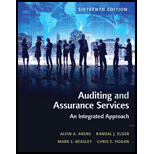
Auditing and Assurance Services, Student Value Edition (16th Edition)
16th Edition
ISBN: 9780134075754
Author: Alvin A. Arens, Randal J. Elder, Mark S. Beasley, Chris E. Hogan
Publisher: PEARSON
expand_more
expand_more
format_list_bulleted
Question
Chapter 14, Problem 24DQP
a.
To determine
Explain the underlying business processes associated with the eight functions for the sales and cash collections.
b.
To determine
Identify the documents or other source evidence that will be used to test the occurrence
transaction-related audit objective for sales for each of the four scenarios.
c.
To determine
Identify the document and other source evidences used to test the occurrence transaction-related audit objective for sales for each of the four scenarios.
d.
To determine
Identify the four scenarios in which the write-off of uncollectible accounts and baddebt expense business functions not be applicable.
Expert Solution & Answer
Want to see the full answer?
Check out a sample textbook solution
Students have asked these similar questions
On the 5th of the month, Greg Marketing pays its field sales personnel a 3% commission on the previous month's sales. Sales for March 2016 were $1,200,000. What is the entry at the end of March to record the commissions?
A. Debit Sales - 36,000$; Credit Sales Commission Expense - 36,000$
B. Debit Sales Commission Expense - 36,000$; Credit Sales Commissions Payable - 36,000$
C. Debit Sales Commission Expense - 36,000$; Credit Accounts Receivable - 36,000$
D. Debit Sales -36,000$; Credit Sales Commission Income - 36,000$
Net profit is calculated in which of the following account?
A) Profit and loss account
B) Balance sheet
C) Trial balance
D) Trading account
The debts which are to be repaid within a short period (a year or less) are referred to as,
A) Current Liabilities
B) Fixed liabilities
C) Contingent liabilities
D) All the above
Chapter 14 Solutions
Auditing and Assurance Services, Student Value Edition (16th Edition)
Ch. 14 - Describe the following documents and records and...Ch. 14 - Prob. 2RQCh. 14 - Prob. 3RQCh. 14 - Prob. 4RQCh. 14 - Prob. 5RQCh. 14 - Prob. 6RQCh. 14 - Prob. 7RQCh. 14 - Prob. 8RQCh. 14 - Prob. 9RQCh. 14 - Prob. 10RQ
Ch. 14 - Prob. 11RQCh. 14 - Prob. 12RQCh. 14 - Prob. 13RQCh. 14 - Prob. 14RQCh. 14 - Prob. 15RQCh. 14 - Prob. 16RQCh. 14 - Prob. 17RQCh. 14 - Prob. 18RQCh. 14 - Prob. 19.3MCQCh. 14 - Prob. 19.1MCQCh. 14 - Prob. 19.2MCQCh. 14 - Prob. 20.1MCQCh. 14 - Prob. 20.2MCQCh. 14 - Prob. 20.3MCQCh. 14 - An auditor is performing substantive tests of...Ch. 14 - Prob. 21.2MCQCh. 14 - Prob. 22.1MCQCh. 14 - Prob. 22.2MCQCh. 14 - Prob. 22.3MCQCh. 14 - Prob. 23DQPCh. 14 - Prob. 24DQPCh. 14 - Prob. 25DQPCh. 14 - Prob. 26DQPCh. 14 - Prob. 27DQPCh. 14 - Prob. 28DQPCh. 14 - Prob. 29DQPCh. 14 - Prob. 30DQPCh. 14 - Prob. 31DQPCh. 14 - Prob. 32DQPCh. 14 - Prob. 33DQPCh. 14 - Prob. 34CCh. 14 - Prob. 35ICA
Knowledge Booster
Similar questions
- Solution this questionarrow_forwardQuestion 2 Long term assets without any physical existence but, possessing a value are called A) Intangible assets B) Fixed assets C) Current assets D) Investmentsarrow_forwardResources owned by a company (such as cash, accounts receivable, vehicles) are reported on the balance sheet and are referred to asarrow_forward
- When are liabilities recorded under the accrual basis of accounting? When incurred When paid At the end of the fiscal year When bank accounts are reconciledarrow_forwardWhich of the following must a certified public accountant (CPA) have in-depth knowledge of to pass the CPA licensing exam? (Check all that apply.) Accounting software packages Auditing Derivatives International banking lawsarrow_forwardCrane Company accumulates the following data concerning a mixed cost, using units produced as the activity level. Units Produced Total Cost March 9,970 $20,005 April 8,930 18,154 May 10,500 20,538 June 8,710 17,674 July 9,370 18,604 Compute the fixed costs using the high-low method. Fixed cost $arrow_forward
arrow_back_ios
SEE MORE QUESTIONS
arrow_forward_ios
Recommended textbooks for you
 Auditing: A Risk Based-Approach (MindTap Course L...AccountingISBN:9781337619455Author:Karla M Johnstone, Audrey A. Gramling, Larry E. RittenbergPublisher:Cengage LearningPrinciples of Accounting Volume 1AccountingISBN:9781947172685Author:OpenStaxPublisher:OpenStax College
Auditing: A Risk Based-Approach (MindTap Course L...AccountingISBN:9781337619455Author:Karla M Johnstone, Audrey A. Gramling, Larry E. RittenbergPublisher:Cengage LearningPrinciples of Accounting Volume 1AccountingISBN:9781947172685Author:OpenStaxPublisher:OpenStax College Auditing: A Risk Based-Approach to Conducting a Q...AccountingISBN:9781305080577Author:Karla M Johnstone, Audrey A. Gramling, Larry E. RittenbergPublisher:South-Western College Pub
Auditing: A Risk Based-Approach to Conducting a Q...AccountingISBN:9781305080577Author:Karla M Johnstone, Audrey A. Gramling, Larry E. RittenbergPublisher:South-Western College Pub

Auditing: A Risk Based-Approach (MindTap Course L...
Accounting
ISBN:9781337619455
Author:Karla M Johnstone, Audrey A. Gramling, Larry E. Rittenberg
Publisher:Cengage Learning

Principles of Accounting Volume 1
Accounting
ISBN:9781947172685
Author:OpenStax
Publisher:OpenStax College

Auditing: A Risk Based-Approach to Conducting a Q...
Accounting
ISBN:9781305080577
Author:Karla M Johnstone, Audrey A. Gramling, Larry E. Rittenberg
Publisher:South-Western College Pub